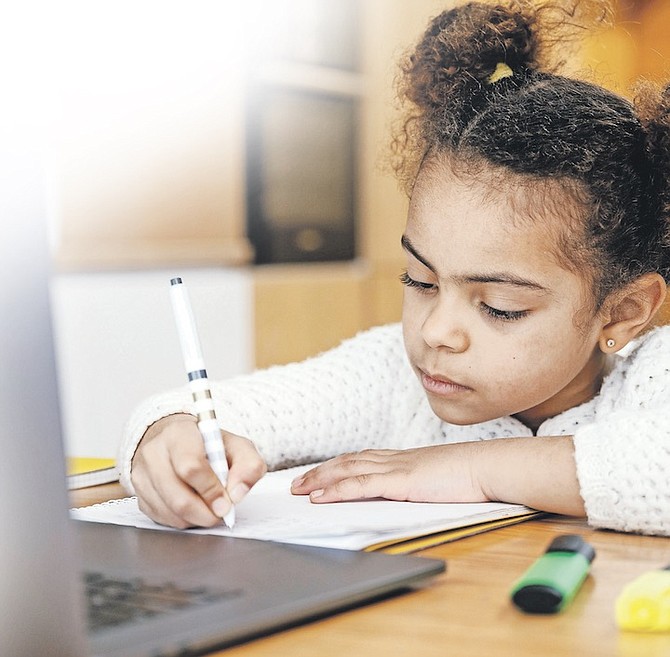The return to the virtual learning environment is difficult for many parents and students. The last school year was difficult, barely transitioning from in-person teaching to the virtual learning environment.
Parents must face several challenges at once. Their children need to have properly functioning devices and internet access at a minimum, and some may need tripods or other stands to keep devices an appropriate height.
They need safe, comfortable work spaces to lay out books and supplies and write. Their spaces need to be appropriately lit and separate from other areas bustling with different kinds of activities that could be distracting to them and others in their classes.
For younger students, there is a need for supervision to ensure they are paying attention and safely using devices as well as the need for technical assistance to manage muting and unmuting, using chat features, adjusting cameras, sharing work and reconnecting to the internet after dips in service.
Supporting virtual learning is not as simple as setting up a device and handing it over to the student.
Lesson plans have to change to suit the virtual environment. It is not helpful to force activities planned for in-person school into the online learning space. It may work for some activities, but this is not what it means to transition or adapt to the demands of virtual school.
Teachers need to engage students in different ways. It is more difficult to keep their attention, provide demonstrations and assess students’ understanding and comfort level with the material. It is not as easy to see to read visual cues. It is also challenging to maintain control of the class as students may become distracted by other tabs and windows on their devices or activities in their physical spaces.
In homes with multiple students, it is even more difficult to create environments conducive to learning. Who is capable of working independently in a more private space like their bedroom? Who can share a common space like the dining room without aggravating or distracting each other? How many headsets are in the house? Who can use noise-cancelling headphones? How will the break times of two or more children be handled in one household? How will parents, working from home, participate in meetings with their children speaking at unpredictable times? Is the workplace making changes to accommodate parents and guardians who share workspace with their children and may need to offer a system at any given time?
The switch to virtual learning is not affecting students alone. Their entire households have to shift to accommodate them. The internet service will not be the same. Meal times will not be the same. Electricity and grocery bills will not be same.
Even the dynamics between people in the household change based on the amount and quality of time they spend together. If they are constantly negotiating limited space, quieting others or being quieted, having to ask for help for give help often, or feeling as though they are receiving more or less attention, it will affect their relationships and behaviour in ways that they did not anticipate. It is not enough to have a brief conversation about the academic expectations for the school year.
There need to be conversations about the way this form of education is affecting the students and the people around them. We may not be able to change the circumstances for the foreseeable future, but we can have conversations that help everyone to better prepare for what is ahead by being honest about what they think it will be like, what they look forward to most, what makes them nervous, the support they think they will need, and what they would like done to make things more comfortable.
If your child is attending school virtually, ask questions that will help you to understand their experience. How do you feel about not seeing your friends every day? How do you think we can try to make up for the time you miss playing together? What was the hardest thing about virtual school last year, and what can we do to make it easier now?
If you are working from home while your child is engaged in virtual learning, talk about your own experience. What was it like for you when you had to transition to working from home? What made it easier? What are you going to do differently now that you know what it is like? What do you do when you are tired of looking at the screen? How do you deal with boredom? What kinds of things did other people do in the house while you were trying to work that upset you? What is the best way for others in the house to let you know they need your help, and how much time do you think you will need before you can respond to them?
There is no reason to pretend everything is fine, to hide the fact we are struggling, or to avoid talking about issues we know will arise.
One of the best things we can do as we navigate a situation we cannot control is to recognize the elements that are within our control, and that includes communication and relationships. When children know parents are having a difficult time too and are identifying ways to deal with it, they have a model for doing the same. They can name the issues and come up with healthy coping mechanisms, even if they are unable to find a solution. Where they have trouble finding ways to cope, adults can help them to come up with Iieas.
It is also possible, then, for parents to talk to teachers about the concerns they have and those raised by their children in order to come up with plan to avoid certain issues, recognize when there is distress, and take action to help the children through it.
In the same way, open conversations about the stressors and complications of the pandemic and how they are affecting work life. Employers need to intentionally create space for employees to raise concerns, share their challenges, offer solutions and support one another without fear of judgment or retribution. For example, someone working from home with children in virtual school can share that their youngest child has a break from 10:00 to 10:15, so that is not the best time to have meetings.
Someone may share their concern that their internet package is not sufficient for the amount of time spent in video calls. An employer can share their observations about productivity and output. There can be space for redistributing tasks, developing internal support systems, moving to a more flexible schedule, and trialing many different ways of conducting work in ways that are responsive to the needs of employees while reaching targets.
Communication needs to be a consistent activity we are excited about engaging in, becoming stronger and more effective each time. It is not a sign of weakness to talk about what we are facing, how we may be affected, and changes we need to make in order to do better than just “making it.” It is a strength to be able to assess ourselves and our situations, hear about other people’s, and find ways to move forward. We spend too much time and energy guessing what others are thinking and the reasons for their behaviour. We are all better off when we can trust each other enough to be honest about vulnerabilities and exercise the kind of thinking and teamwork that leads to the identification of systems and practices to sustain collective forward movement.
What have you assumed lately? What questions can you ask to get clear answers? What are you prepared to share, and what are you prepared to hear? How can you support the people in your space as you all navigate this challenging environment?
The pandemic is not ending any time soon. We are not yet at the peak of the third wave. Our work and school circumstances are not likely to improve in the near future. For those who have not already done so, it is time to get real about where we are, recognize we are interdependent, and open up conversations about what we can do to help each other (and ourselves) along. Ask the questions you keep trying to answer for yourself, listen without judgment to what people need you to know, resist the urge to correct or argue about people’s perspectives, and focus on addressing the concerns that come up. Plan for collective success.






Comments
Levettefarry 2 years, 7 months ago
Well-said, Ms. Wallace! There is much to be considered and discussed, as it relates to this topic, such as bearing in mind that teachers are now faced with compounding issues where their jobs and home-lives are concerned. We must make life-adjustments as well, just like everyone else and sometimes I think the public forgets this.
I read some responses to a story on Our News in recent weeks where educators were stating that they needed more time to ensure that all, if not most of the issues related to teaching virtually can be worked out, in order for us to work at an optimum level, and people jumped all over it! They said things like, "how much more time do they need?" and "these some lazy teachers!" I just shook my head and said to myself, 'if they only knew, he who feels it knows it." What teachers need now, is support and encouragement, just like everyone else, but even more so, because of the nature of our vocation. It is my prayer that we as a nation can come to understand this and act upon it.
I said all of this to say, I agree with you, that we must not only, support each other and communicate in the most sensible of ways, but we must also learn to understand each other, if we are to make the "collective success" that you spoke so poignantly about.
Sign in to comment
Or login with:
OpenID